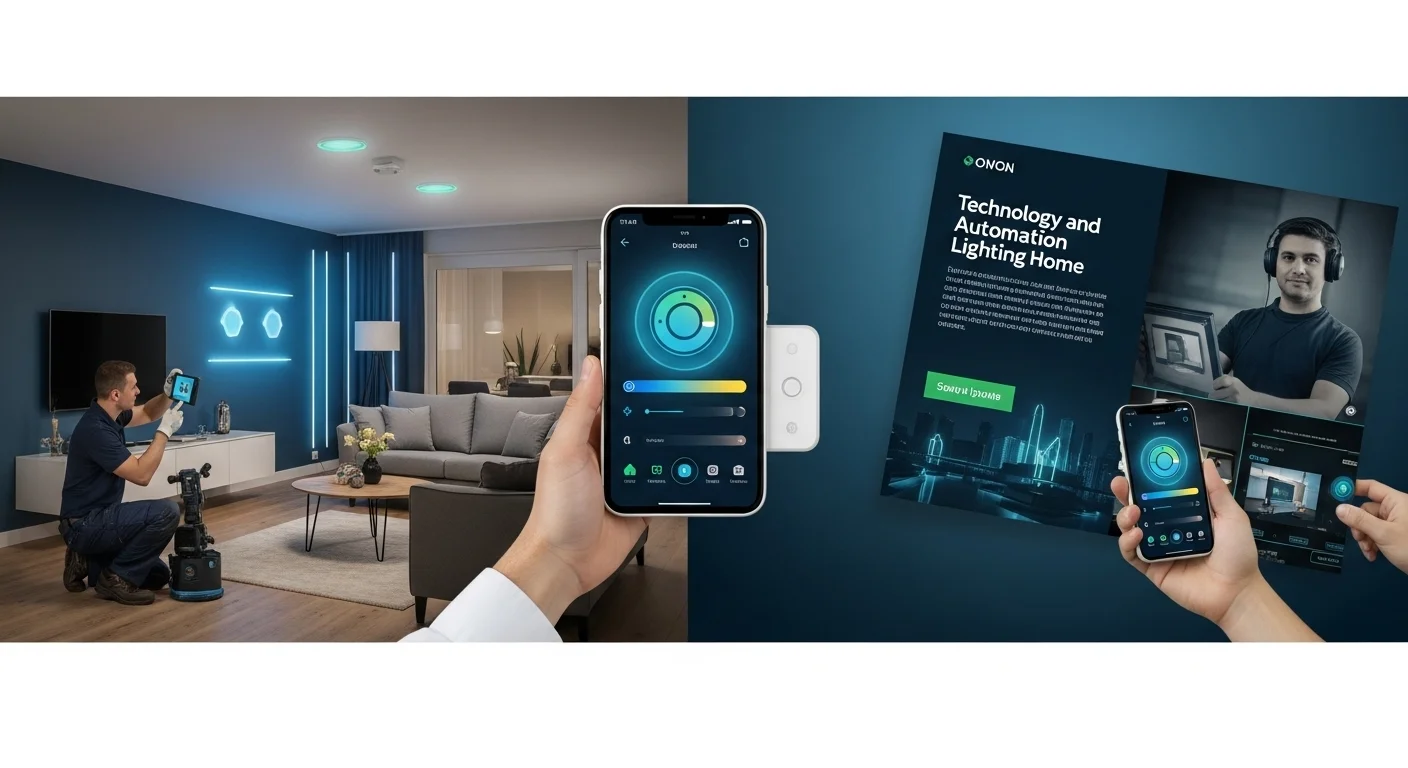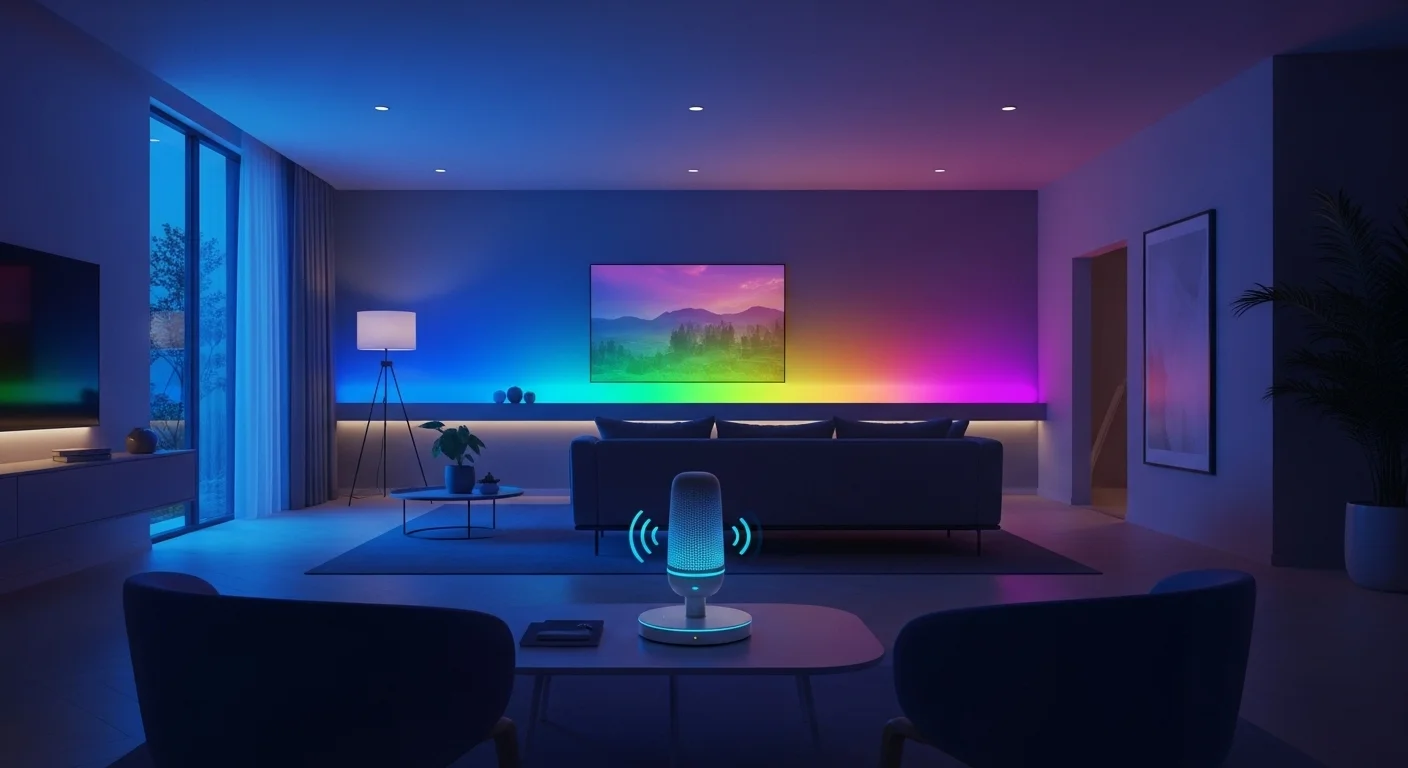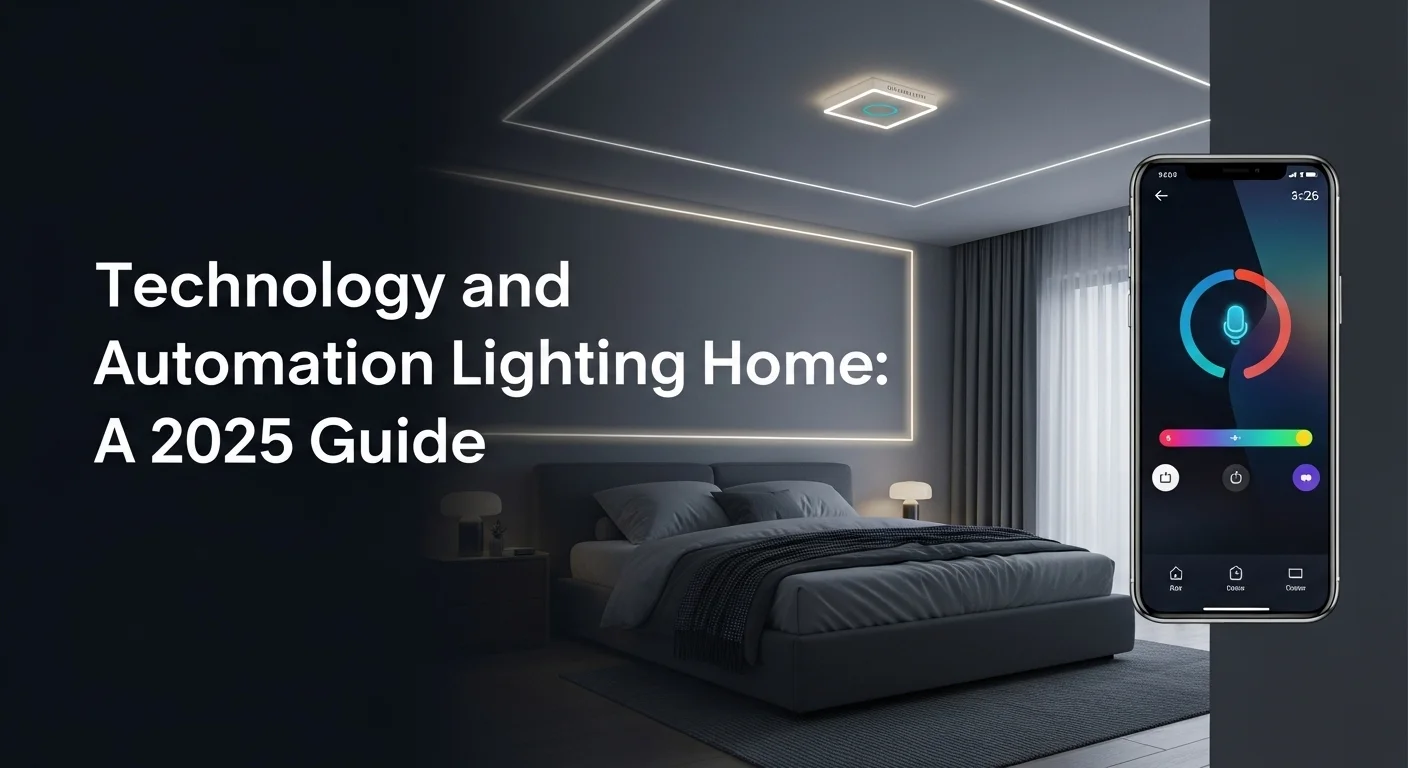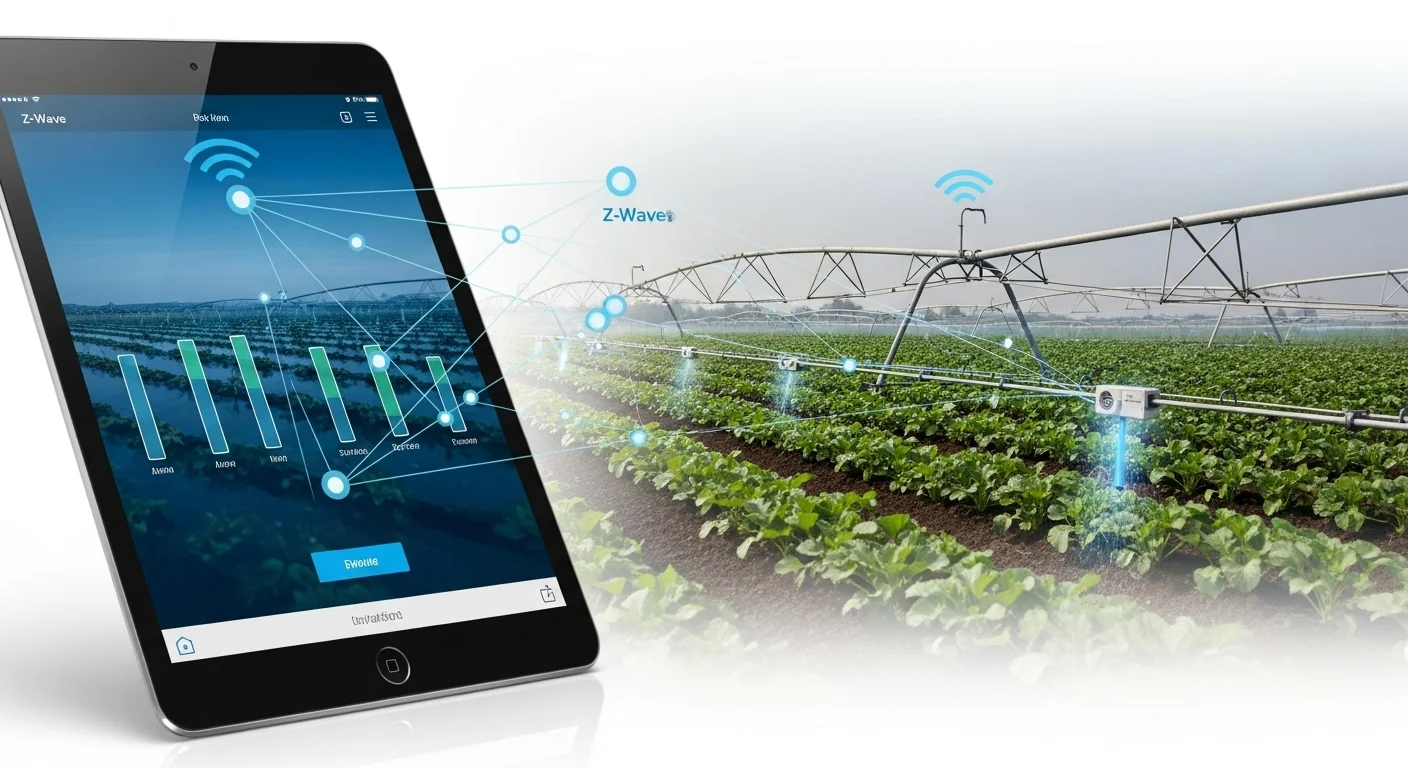Smart Home Lighting Automation: My Ultimate Guide for 2025

Executive Summary
In the world of smart technology, nothing makes a bigger impact on your daily life than smart lighting. I’ve spent years helping people and businesses set up automated spaces, and lighting is always the change that gets the biggest 'wow.' This guide is where I'll share everything I've learned about home lighting automation. We'll explore the tech that makes it all possible and the incredible benefits it brings to the table, from cutting down your energy bills and making your home more secure to setting the perfect mood with a single tap. We’ll look at the best systems out there, whether you're a DIY enthusiast or a business owner looking to create a smarter, more productive environment. We'll cover everything from the basics of a connected lighting system to advanced strategies using AI. My goal is to give you the insights you need to build a more intelligent, responsive, and enjoyable space to live and work in.
Table of Contents
What is Home Lighting Automation and Why Does It Matter?
I've spent over a decade in smart home integration, and if there's one technology that truly transforms a space, it's lighting automation. At its simplest, it’s about using technology to control your lights automatically, moving way beyond a simple wall switch. It's a key part of what we call the Internet of Things (IoT), where everyday devices are connected and can 'talk' to each other. By bringing your lights into this network, you unlock a whole new level of control and efficiency that can genuinely make your life better and your business smarter. For me, its importance comes from its ability to turn a boring, static part of a building into something dynamic and helpful.
Basically, home lighting automation means swapping your old bulbs and switches for smart ones you can control from anywhere and program to do things on their own. The setup usually involves three key parts: the smart devices themselves (like LED bulbs or smart switches), a central hub that acts as the brain, and an app on your phone or a voice assistant like Alexa or Google Assistant. The real magic is in the wireless protocols they use. In the early days, things were complicated, but now we have standards like Wi-Fi, Bluetooth, Zigbee, and Z-Wave. Wi-Fi is easy because it connects right to your home router, while Zigbee and Z-Wave create their own special network for your smart devices, which is super reliable and doesn't slow down your internet. The most exciting development is the new Matter protocol. It's backed by all the big names—Apple, Google, Amazon—and its goal is to make all these different devices work together seamlessly, finally creating a truly connected automated home lighting system without the headaches.
The Real-World Benefits of Smart Lighting
The impact of smart lighting home automation is huge. It makes the whole idea of the IoT real for people. It's not just a cool gadget; it provides tangible benefits that I see my clients enjoy every day:
- Saves Money and Helps the Planet: This is the benefit that gets everyone's attention first. Automated systems can slash your energy use. I've seen clients cut their lighting bills by more than half. Features like occupancy sensors, which turn lights off when you leave a room, and daylight harvesting, which dims your lights when it's sunny outside, eliminate waste. You can also set schedules so lights are only on when you need them. Plus, smart bulbs are almost always LEDs, which use about 80% less energy and last years longer than old incandescent bulbs. It’s a win for your wallet and a win for the environment.
- A Serious Boost to Security and Safety: A connected automated home lighting system is one of my favorite security tools. When I go on vacation, I use the 'away' mode to have my lights turn on and off randomly, making it look like someone's home. It’s a simple but effective deterrent. You can also link your lights to security cameras, so if motion is detected, your lights flash to scare off intruders. For safety inside, I always recommend programming lights to turn on if a smoke alarm goes off, lighting up escape routes. Motion-activated lights in hallways are also a lifesaver for preventing trips and falls at night.
- Incredible Convenience and Personalization: Being able to control every light in your house from your phone or with your voice is a game-changer. I love helping clients create 'scenes' for different activities. We'll set up a 'Movie Night' scene that dims the main lights and turns on some cool accent lighting, or a 'Focus' scene for the home office that provides bright, clear light. You can instantly change the entire vibe of a room. It lets you tailor your home to your life, not the other way around.
- Better Productivity and Well-being at Work: In an office, the right lighting does more than just save energy. We can install systems that change the color and brightness of the light during the day to match our natural body clocks. This is called human-centric lighting. A brighter, cooler light in the morning helps everyone feel awake and productive, while a warmer, dimmer light in the afternoon is easier on the eyes. It leads to a happier, healthier, and more focused team. In stores, we use dynamic lighting to make products pop and create a welcoming atmosphere that can actually guide customers and boost sales.
When you start a project for automating lights at home or work, remember you're not just installing lights. You're building the foundation for a smarter building. It's an investment that opens the door to so much more. As AI gets even better, these systems will learn our routines and start anticipating what we need, making them an even more essential part of our lives.

A Complete Guide to Smart Lighting for Your Home and Business
Starting a smart lighting project, whether it’s for your home or your business, means having a clear plan. You need to understand the different systems, how they're installed, and how you can use them to your advantage. As someone who has navigated this process countless times, I can guide you through the technical choices, business applications, and comparisons you'll need to make a smart decision about home lighting automation.
Technical Methods: DIY vs. Professional Installation
The very first fork in the road is deciding whether to install the system yourself or hire a professional. Your choice will come down to the size of your project, how comfortable you are with technology, and your budget.
- DIY Installation: If you're a bit of a tech enthusiast or are just starting with a single room, the DIY path is fantastic and very rewarding. I started out this way myself! Systems built around smart bulbs (like Philips Hue) or smart plugs are made for easy, user-friendly setup. It’s usually as simple as screwing in a bulb, plugging in a device, and following the steps in a mobile app. The biggest pros are the low upfront cost and the freedom to tweak everything yourself. The downside is that it can take time to learn, especially if you're trying to mix and match brands, and you're the one who has to troubleshoot if something goes wrong. For small projects, DIY is a great way to go.
- Professional Installation: For a whole-home system or any kind of commercial project, I almost always recommend hiring a professional. A pro brings a level of expertise that ensures everything works perfectly together. They can handle complex wiring, integrate your home lighting automation systems with your heating and security, and make sure it's all up to code. Yes, it costs more upfront because of labor, but it saves you massive headaches and guarantees you get a polished, reliable system. Brands like Lutron and Crestron are industry leaders that typically require a professional to get the most out of them.
Comparing Home Lighting Automation Systems
The market is full of great options, but they excel in different areas. Here’s my take on some of the most popular systems:
- Philips Hue: I often call this the gold standard for home smart lighting. Hue has a massive range of high-quality bulbs, light strips, and accessories. It runs on a Zigbee-based network, so you need their Hue Bridge (a small hub), but that's what makes it so incredibly fast and reliable. They are famous for their amazing color options, a super intuitive app, and flawless integration with Alexa, Google Assistant, and Apple HomeKit. It's a premium choice, but if you want a powerful and expandable system that just works, this is it.
- Lutron Caséta: Lutron focuses more on the switch than the bulb. Their smart dimmers and switches make your existing fixtures smart, which many of my clients prefer. They use their own super-reliable radio frequency technology that never interferes with Wi-Fi. It's rock-solid. You'll need their smart bridge, but it works perfectly with all the major smart home platforms. For professional-grade reliability in a DIY-friendly package, especially for an entire house, Lutron is my top pick.
- Wyze: For anyone on a budget, Wyze is impossible to ignore. They offer a great lineup of affordable smart bulbs, plugs, and strips. Their products connect directly to your Wi-Fi, so there’s no hub needed, which simplifies things. The app is straightforward and provides all the core features like scheduling and automations. It's the perfect entry point for anyone curious about automating lights at home without a big investment.
- Ring: Known for security, Ring's smart lighting is designed to work as part of that system. They offer pathlights, spotlights, and floodlights that integrate perfectly with their cameras and doorbells. When your camera detects motion, it can instantly trigger the lights to come on, which is a powerful security feature. If your main goal is to bolster your home security, Ring's connected automated home lighting system is the logical choice.
Business Solutions and Applications
Beyond the home, automated lighting is a game-changer for businesses, impacting everything from the bottom line to employee morale.
- Offices and Corporate Spaces: Businesses can save a fortune on energy. Imagine conference rooms and offices where lights automatically turn off when they're empty. We also install human-centric lighting that adjusts throughout the day to boost focus and reduce eye strain. It creates a healthier and more productive workplace. From a central dashboard, a facilities manager can control the entire building and even get alerts when a bulb is about to fail.
- Retail and Hospitality: In a store, a smart lighting system can create an unforgettable shopping experience. We can use light to highlight a new clothing line, change the store's mood for a holiday season, or even guide shoppers with light. In hotels, it creates a premium feel—a guest walks into their room and a 'Welcome' scene turns on. It’s a touch of luxury that also saves energy in empty rooms.
- Industrial and Warehouses: In huge spaces like warehouses, lighting is a massive expense. An automated system with scheduling and sensors can deliver incredible savings. It also makes the workspace safer by ensuring areas are always perfectly lit when people are present. Some advanced systems can even track assets by having sensors on forklifts talk to the lights overhead.
In the end, a great smart lighting strategy is about matching the right technology to your goals. Whether you want to save money, add convenience, boost security, or create a more productive workspace, there's a system that can redefine what light can do for you.

Tips and Strategies to Perfect Your Smart Lighting Experience
Getting a smart lighting system up and running is one thing, but making it truly *smart* is another. It’s all about thoughtful design and clever automation that makes your environment feel intuitive and responsive. As someone who lives and breathes this stuff, I've gathered some best practices and advanced automation strategies to help you get the absolute most out of your home lighting automation setup. Let's make your space brilliant.
Best Practices for System Design and Setup
A little planning goes a long way. The biggest mistake I see people make is buying a box of smart bulbs and just screwing them in randomly. A great experience starts with a good design.
- Plan Before You Buy: Before you even think about shopping, walk through your space and think about how you use it. Where do you read? Where do you cook? Where do you relax? Plan your lighting around those activities. I always suggest making a rough sketch of the room and marking where you need different types of light: task lighting for activities, ambient light for general brightness, and accent lighting to highlight art or architectural features.
- Stick to One Ecosystem to Start: While things are getting better with the new Matter standard, my advice for beginners is to start with a single ecosystem, like Philips Hue or Lutron. This guarantees all your devices will play nicely together, you'll only need one app, and troubleshooting will be much simpler.
- Layer Your Light: Please don't rely on one harsh overhead light for an entire room. It's unflattering and inefficient. The secret to beautiful lighting is to use layers. Combine smart ceiling lights with floor lamps, table lamps, and maybe some LED strips behind a TV or under cabinets. This spreads the light out, creating a balanced and inviting atmosphere. A pro tip: placing lights in corners can make a room feel bigger.
- Use Color Thoughtfully: Having millions of colors at your fingertips is fun, but for daily use, less is more. I use color as an accent—a soft green to make my houseplants look more lush, or a color that matches an accent wall to deepen its effect. For everyday living, focus on tunable white light. A cool, bright white is perfect for waking up in the morning, while a warm, soft white is ideal for relaxing in the evening.
Advanced Automation Strategies: Scenes, Schedules, and Sensors
This is where the magic happens. Moving beyond manually controlling your lights is what makes your home truly smart.
- Create Meaningful Scenes: Scenes are your custom lighting recipes. Think beyond just 'On' and 'Off.' I have a 'Cooking' scene that blasts my kitchen counters with bright, cool light. My 'Wind Down' scene slowly dims everything to a warm, candle-like glow an hour before I go to bed. And my 'Good Morning' scene gently fades my bedroom lights on like a sunrise, which is a much nicer way to wake up than a blaring alarm.
- Use Smart Scheduling: This is automation at its most basic and most useful. I have my outdoor lights set to turn on at sunset and off at sunrise automatically. If your routine is predictable, schedule your lights to match it. For security, don't just set a fixed schedule when you're away. Use a 'Vacation Mode' that turns lights on and off at slightly different times each day to make it look like you're really home.
- Add Sensors for a Hands-Free Home: This is how you make automating lights at home feel effortless. I have motion sensors in my hallway, laundry room, and bathrooms. The lights turn on when I walk in and off a few minutes after I leave. I never have to touch a switch. You can also put small contact sensors on closet doors to have the light turn on the moment you open them.
- Try Geofencing: Geofencing uses your phone's location to trigger automations. I have it set up so when my phone leaves a certain radius around my house, it checks if any lights were left on and turns them off. When I arrive home, the entryway and kitchen lights turn on automatically. It saves energy and provides a warm welcome every time.
Cybersecurity and Future-Proofing Your System
As with any internet-connected device, your connected automated home lighting system needs to be secure. Don't overlook this—it's like leaving your digital front door unlocked.
- Secure Your Wi-Fi: Your first line of defense is your router. Make sure you're using a strong, unique password and WPA3 encryption if it's available. And please, change the default admin password on the router itself!
- Use Strong Passwords and 2FA: Every smart home app needs its own unique, complex password. Turn on two-factor authentication (2FA) wherever you can. It adds a crucial second step to logging in, usually a code sent to your phone.
- Keep Firmware Updated: Manufacturers release updates to fix security holes and add features. Turn on automatic updates in your smart lighting apps to stay protected.
- Consider a Guest Network: For extra security, you can put all your smart home gadgets on a separate guest Wi-Fi network. This keeps them isolated from your personal computers and phones where your sensitive data lives.
Looking ahead, Artificial Intelligence (AI) is going to make these systems even more incredible. They'll learn your habits and start to anticipate your needs without you having to program anything. For example, your system might learn you like dimmer lights on cloudy days and adjust them for you. As you build out your system, keep an eye out for devices that support universal standards like Matter to ensure they'll work with whatever comes next. And for the real tech hobbyists who want ultimate control, you have to check out the open-source Home Assistant platform—it's a playground for integrating just about any smart device you can imagine.
Expert Reviews & Testimonials
Sarah Johnson, Business Owner ⭐⭐⭐
Good information on home lighting automation, but as a business owner, I was hoping for a few more real-world case studies for commercial spaces.
Mike Chen, IT Consultant ⭐⭐⭐⭐
A solid overview of home lighting automation. It helped me connect the dots, though a couple of the technical explanations were a bit dense.
Emma Davis, Tech Expert ⭐⭐⭐⭐⭐
Fantastic article! So comprehensive on home lighting automation. This was incredibly helpful for my own specialization, and everything was explained perfectly.



